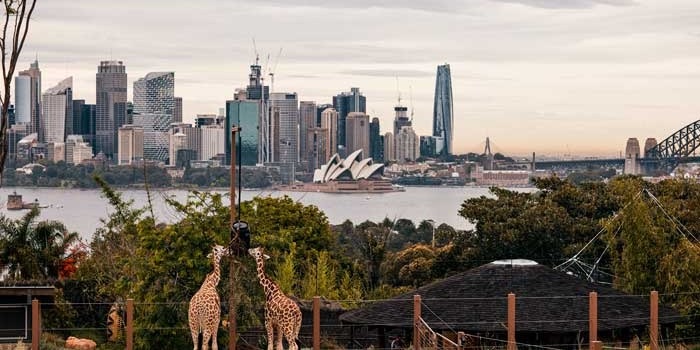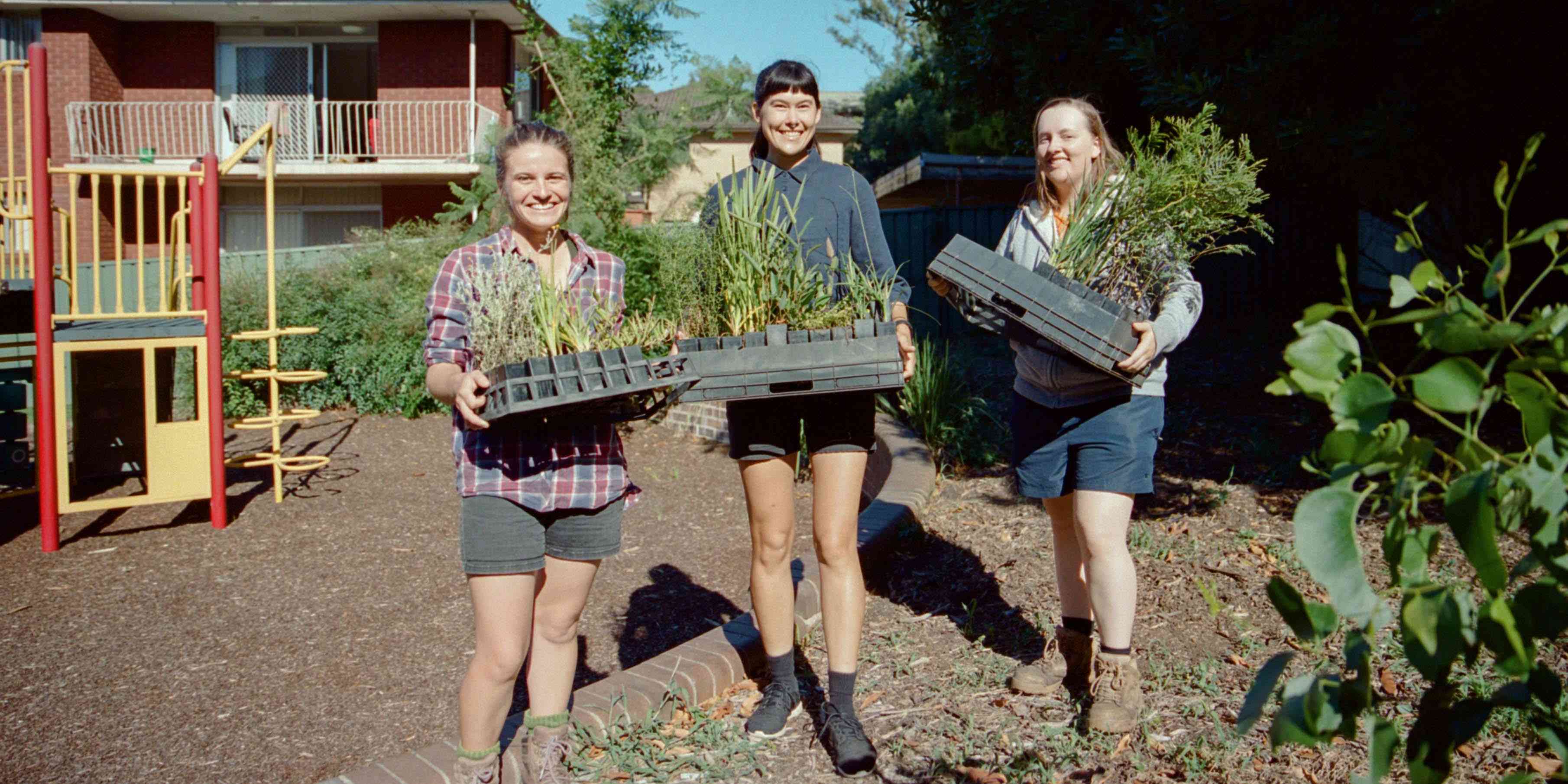Key points
- Green cover and open spaces are important in towns and cities because they provide health, wellbeing and ecological benefits. Examples of green cover and open spaces include natural and semi-natural areas, such as remnant bushland, parks, gardens and infrastructure such as plant walls and green roofs.
- Green cover and open spaces provide natural cooling of air and surfaces, and support water management in urban areas. The vegetation used in these areas absorbs carbon dioxide, helping to offset greenhouse gas emissions.
- Climate change is causing more severe and frequent heatwaves, drought, rainfall and storms. These extreme weather events affect our towns and cities, and impact green cover and open spaces, reducing their ability to mitigate against future impacts.
- Increasing the amount of green cover and open spaces can help to combat the effects of climate change. This is achieved by providing natural cooling of air and surfaces, supporting water management in urban areas and capturing carbon dioxide from the atmosphere. This will help to keep our cities and towns resilient and liveable in the future.
The importance of green cover and open spaces in NSW
Green cover and open spaces are important aspects of NSW towns and cities. They provide health, wellbeing and ecological benefits, and help to combat the effects of climate change.
Examples of green cover include remnant bushland, private and community gardens, parks, biodiversity corridors, nature reserves and trails, sporting ovals, street trees and rooftop gardens.
Open spaces include other non-developed areas, such as waterways, foreshores and sand dunes.
These types of green cover and open spaces are key aspects of ‘green infrastructure’ – the network of green spaces, natural and semi-natural systems that supports sustainable communities. These areas of green cover and open space help protect us and our built environments against some of the impacts of climate change, such as increased urban heat and natural hazards.
The temperatures in large cities can be 1 °C to 3 °C higher than average rural temperatures. This is known as the urban heat island effect, and occurs because buildings, roads and other hard surfaces absorb and store more heat compared to surrounding areas. Climate change is causing temperatures to increase, which will be felt more in our urban areas, due to the urban heat island effect.
Green cover and open spaces help to balance the temperatures in cities and towns, counteracting urban heat. Trees and other tall vegetation provide shade, and cool and clean the air by evapotranspiration. For some locations, it has been estimated that evapotranspiration can reduce peak summer temperatures by 5 °C.
Green cover and open spaces act as natural buffers between the built environment and natural hazards such as floods. Green cover can be allowed to flood and absorb water (unlike concrete or asphalt). This improves the management of flood and stormwater, especially during heavy rainfall events, which helps to avoid damage to built environments. Open spaces and fire-resistant trees and shrubs are important landscape design elements that can help to protect buildings and urban areas from fires.
Green cover and open spaces can also:
- reduce soil erosion
- provide refuge and protection for native, threatened or endangered plants and animals, enhancing biodiversity and wildlife in urban areas
- improve the comfort, health and wellbeing of people living in towns and cities
- reduce pollution levels and improve air quality
- provide space for people to commute, socialise and exercise
- help limit the rate of climate change through vegetation’s ability to absorb and store carbon dioxide.
How green cover and open spaces are affected by climate change in NSW
Although green cover and open spaces help to combat the effects of climate change, these spaces are still vulnerable to climate change itself, just like other parts of our landscape and society.
Climate change affects how we maintain green cover and open spaces and associated costs. Urban green spaces need regular maintenance and watering to ensure they stay healthy and deliver benefits to people and the environment. Heatwaves, drought, and policies such as water restrictions can affect plant health and the positive benefits of urban green cover and open space. As vegetation dies, its ability to balance temperatures and fight the urban heat effects diminishes.
In extreme events such as storms, high winds and East Coast Lows, open space and green cover can be affected through fallen trees and limb drop. Rising sea levels and coastal erosion will also put existing parks and open spaces near the ocean at risk.
It is important that councils and other land managers consider these issues in management plans to reduce risks to life and property. There are various tools that are available to help.
How green cover and open spaces can help us adapt to climate change
Increasing the amount of green cover and open spaces has many benefits in protecting us from the effects of climate change. Protecting local green spaces and creating urban networks of green space can help to minimise the impacts of urban heat in our cities and towns.
Vegetation included in urban design has the added benefit of absorbing and storing carbon dioxide, helping to limit the rate of climate change. A mature tree can absorb up to 150 kg of carbon dioxide every year – planting 12 trees can offset one year’s worth of a person’s entire carbon dioxide emissions.
Government policies and strategies such as the Sydney Green Grid and Greener Places Framework are supporting the establishment of a network of green cover and open space in our largest city. Delivering a network of open spaces will help keep the city cool, encourage healthy living, enhance biodiversity an ensure ecological resilience. The NSW Government is also committed to delivering 2 of the Premier’s Priorities for a better environment:
- Greener Public Spaces – where the NSW Government is looking to create green public spaces by increasing the proportion of homes in urban areas within 10 minutes’ walk of quality green, open and public space by 10% by 2023. Incorporating more vegetation and green spaces into urban areas will help balance temperatures and reduce the urban heat island effect.
- Greening Our City – with a goal to increase the tree canopy and green cover across Greater Sydney by planting 1 million trees by 2022. This is part of the broader 5 Million Trees program that aims to plant 5 million trees by 2030 and help reach the Greater Sydney Region Plan’s target of 40% canopy for Greater Sydney.
Using green cover and open spaces offers a way to adapt to climate change that can be applied across many urban settings. However, it is important to ensure that local conditions are properly considered and planned for.
In partnership with the Clean Air and Urban Landscapes (CAUL) Hub, the NSW Government has delivered a baseline dataset to assess urban heat and green cover in the Sydney Greater Metropolitan Area. This allows planners and policy makers to assess ways to adapt urban areas to create more liveable cities.
Through CAUL, local decision makers will be able to understand and monitor tree and shrub cover in local government areas. This enables decision makers to look at green cover at the street level in their districts.
Related information
Greener places – NSW Government
Greening our City – NSW Government
Which Plant Where - Future proof urban landscape projects with climate-ready species



